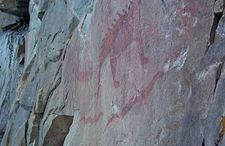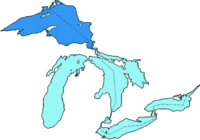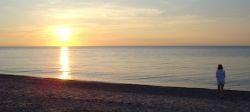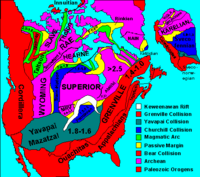Difference between revisions of "Lake Superior" - New World Encyclopedia
Betsy Brooks (talk | contribs) |
Betsy Brooks (talk | contribs) |
||
| Line 58: | Line 58: | ||
Lava erupting from the rift cooled, forming the black basalt rock of Michipicoten Island, Black Bay Peninsula, and St. Ignace Island. | Lava erupting from the rift cooled, forming the black basalt rock of Michipicoten Island, Black Bay Peninsula, and St. Ignace Island. | ||
| − | Around 1.6 million years ago, during the last Great [[Ice Age]], ice covered the region at a thickness of 1.25 miles (2 km). The land contours familiar today were carved by the advance and retreat of the ice sheet. The retreat, 10,000 years ago, left gravel, sand, clay, and boulder deposits. Glacial meltwaters gathered in the Superior basin creating [[Glacial Lake Minong|Lake Minong]], a precursor to Lake Superior.<ref>Chisholm & Gutsche, ''ibid'', p. xv</ref> Without the immense weight of the ice, the land | + | Around 1.6 million years ago, during the last Great [[Ice Age]], ice covered the region at a thickness of 1.25 miles (2 km). The land contours familiar today were carved by the advance and retreat of the ice sheet. The retreat, 10,000 years ago, left gravel, sand, clay, and boulder deposits. Glacial meltwaters gathered in the Superior basin creating [[Glacial Lake Minong|Lake Minong]], a precursor to Lake Superior.<ref>Chisholm & Gutsche, ''ibid'', p. xv</ref> Without the immense weight of the ice, the land rebounded, and a drainage outlet formed at [[Sault Ste. Marie]], which would become known as [[St. Marys River (Michigan-Ontario)|St. Mary's River]]. |
== Geography == | == Geography == | ||
| − | The largest island in Lake Superior is [[Isle Royale]] | + | The largest island in Lake Superior is [[Isle Royale]], part of the US state of [[Michigan]], off the Upper Peninsula. Other large islands include [[Madeline Island]] in the US state of [[Wisconsin]] and Michipicoten in the Canadian province of [[Ontario]]. |
The larger towns on Lake Superior include: the twin ports of [[Duluth, Minnesota]] and [[Superior, Wisconsin]]; [[Thunder Bay, Ontario]]; [[Marquette, Michigan]]; and the two cities of [[Sault Ste. Marie]], in [[Sault Ste. Marie, Michigan|Michigan]] and in [[Sault Ste. Marie, Ontario|Ontario]]. Duluth, at the western tip of Lake Superior, is the most inland point on the [[St. Lawrence Seaway|Saint Lawrence Seaway]] and the most inland port in the world. | The larger towns on Lake Superior include: the twin ports of [[Duluth, Minnesota]] and [[Superior, Wisconsin]]; [[Thunder Bay, Ontario]]; [[Marquette, Michigan]]; and the two cities of [[Sault Ste. Marie]], in [[Sault Ste. Marie, Michigan|Michigan]] and in [[Sault Ste. Marie, Ontario|Ontario]]. Duluth, at the western tip of Lake Superior, is the most inland point on the [[St. Lawrence Seaway|Saint Lawrence Seaway]] and the most inland port in the world. | ||
| Line 67: | Line 67: | ||
[[image:North america basement rocks.png|right|thumb|200px|North American [[craton]]s and basement rock, showing the formation of the [[Midcontinent Rift System|Midcontinent Rift]] containing today's Lake Superior]] | [[image:North america basement rocks.png|right|thumb|200px|North American [[craton]]s and basement rock, showing the formation of the [[Midcontinent Rift System|Midcontinent Rift]] containing today's Lake Superior]] | ||
| − | Among the scenic | + | Among the scenic areas on the lake are: the [[Apostle Islands National Lakeshore]]; [[Isle Royale National Park]]; [[Pukaskwa National Park]]; [[Lake Superior Provincial Park]]; [[Grand Island National Recreation Area]]; [[Sleeping Giant (Ontario)]];and [[Pictured Rocks National Lakeshore]]. |
| Line 74: | Line 74: | ||
[[image:LakeSuperior_arf.JPG|200px|right|thumb|Lake Superior in winter, as seen from [[Duluth, Minnesota|Duluth]] in December 2004]] | [[image:LakeSuperior_arf.JPG|200px|right|thumb|Lake Superior in winter, as seen from [[Duluth, Minnesota|Duluth]] in December 2004]] | ||
| − | Lake Superior is the largest [[Fresh water|freshwater]] [[lake]] in the world by surface area. [[Lake Baikal]] in [[Russia]] is larger by volume, as is [[Lake Tanganyika]]. The [[Caspian Sea]], while vastly larger than Lake Superior in both surface area and volume, is saline; | + | Lake Superior is the largest [[Fresh water|freshwater]] [[lake]] in the world by surface area. [[Lake Baikal]] in [[Russia]] is larger by volume, as is [[Lake Tanganyika]]. The [[Caspian Sea]], while vastly larger than Lake Superior in both surface area and volume, is saline; presently isolated, in the past, it has been repeatedly connected to, and isolated from, the [[Mediterranean]] via the [[Black Sea]]. |
| − | Lake Superior (48°00’N, 88°00’W) has a surface area of 31,820 square miles (82,414 km²)<ref name=nyt/>—which is larger than [[South Carolina]]. It has a maximum length of 350 miles (563 km) and maximum | + | Lake Superior (48°00’N, 88°00’W) has a surface area of 31,820 square miles (82,414 km²)<ref name=nyt/>—which is larger than thr US state of [[South Carolina]]. It has a maximum length of 350 miles (563 km) and maximum width of 160 miles (257 km). Its average depth is 483 feet (147 m) with a maximum depth of 1,333 feet (406 m).<ref name=nyt/> Lake Superior contains [[1 E12 m³|2,900 cu mi (12,100 km³)]] of water. There is enough water in Lake Superior to cover the entire land mass of [[North America|North]] and [[South America]] with a [[Foot (unit)|foot]] (30 cm) of water. The shoreline of the lake stretches 2,726 miles (4,385 km) (including [[islands]]). The lake's elevation is 600 feet (183 m)<ref name=nyt/> above sea level. American [[Limnology|limnologist]] [[J. Val Klump]] was the first person to reach the lowest depth of Lake Superior on July 30, 1985 as part of a scientific expedition. |
Annual storms on Lake Superior regularly record wave heights of over 20 feet (6 m).[http://www.crh.noaa.gov/mqt/fitzgerald/gales.php] Waves well over 30 feet (9 m) have been recorded.<ref>Chisholm, B. & Gutsche, A., ''Superior: Under the Shadow of the Gods'', Lynx Images, 1998, p. xiii</ref> | Annual storms on Lake Superior regularly record wave heights of over 20 feet (6 m).[http://www.crh.noaa.gov/mqt/fitzgerald/gales.php] Waves well over 30 feet (9 m) have been recorded.<ref>Chisholm, B. & Gutsche, A., ''Superior: Under the Shadow of the Gods'', Lynx Images, 1998, p. xiii</ref> | ||
| Line 83: | Line 83: | ||
=== Tributaries and outlet === | === Tributaries and outlet === | ||
| − | The lake is fed by over 200 rivers. The largest include the [[Nipigon River]], the [[Saint Louis River|St. Louis River]], the [[Pigeon River (Minnesota-Ontario)|Pigeon River]], the [[Pic River]], the [[White River (Ontario)|White River]], the [[Michipicoten River]], [[the Brule River]] and the [[Kaministiquia River]]. Lake Superior drains into [[Lake Huron]] by the [[St. Marys River (Michigan-Ontario)|St. Marys River]]. The rapids on the river necessitate the [[Soo Locks|Sault Locks]] (pronounced "soo"), a part of the [[Great Lakes Waterway]], to move boats over the 25 foot (7.6 m) height difference from Lake Huron. | + | The lake is fed by over 200 rivers. The largest include the [[Nipigon River]], the [[Saint Louis River|St. Louis River]], the [[Pigeon River (Minnesota-Ontario)|Pigeon River]], the [[Pic River]], the [[White River (Ontario)|White River]], the [[Michipicoten River]], [[the Brule River]], and the [[Kaministiquia River]]. Lake Superior drains into [[Lake Huron]] by the [[St. Marys River (Michigan-Ontario)|St. Marys River]]. The rapids on the river necessitate the [[Soo Locks|Sault Locks]] (pronounced "soo"), a part of the [[Great Lakes Waterway]], to move boats over the 25 foot (7.6 m) height difference from Lake Huron. |
=== Climate === | === Climate === | ||
| − | Lake Superior's size creates a localized [[oceanic climate|oceanic]] or [[maritime climate]] (more typically seen in locations like [[Nova Scotia]]) <ref>[http://www.thekingshighway.ca/scenic.html Highway 17: A Scenic Route along the northern Lake Superior shore]</ref>. The water's slow reaction to | + | Lake Superior's size creates a localized [[oceanic climate|oceanic]] or [[maritime climate]] (more typically seen in locations like [[Nova Scotia]]) <ref>[http://www.thekingshighway.ca/scenic.html Highway 17: A Scenic Route along the northern Lake Superior shore]</ref>. The water's slow reaction to changing temperatures helps to moderate surrounding air temperatures in the [[summer]] and [[winter]], and creates [[lake effect snow]] in colder months. The hills and [[mountain]]s that border the lake form a bowl, which holds moisture and fog, particularly in the fall. |
==Ecology== | ==Ecology== | ||
Revision as of 20:13, 5 July 2007
| Lake Superior | |
|---|---|
| Coordinates | Coordinates: |
| Primary sources | Nipigon River, St. Louis River Pigeon River Pic River White River Michipicoten River Kaministiquia River |
| Primary outflows | St. Marys River |
| Basin countries | Canada, USA |
| Max length | 563 km (350 mi) |
| Max width | 257 km (160 mi) |
| Surface area | 82,414 km² (31,820 mi²)[1] Canadian portion 28,700 km² (11,080 mi²) |
| Average depth | 147 m (482 ft) |
| Max depth | 406 m (1333 ft)[1] |
| Water volume | 12,100 km³ (2900 mi³) |
| Residence time (of lake water) | 191 years |
| Shore length1 | 4385 km (2725 mi) |
| Surface elevation | 183 m (600 ft)[1] |
| Islands | Isle Royale Apostle Islands |
| Settlements | Duluth, Minnesota Superior, Wisconsin Thunder Bay, Ontario Marquette, Michigan Sault Ste. Marie, Michigan Sault Ste. Marie, Ontario |
| 1 Shore length is an imprecise measure which may not be standardized for this article. | |
Lake Superior, bounded by Ontario, Canada and Minnesota, US, to the north and Wisconsin and Michigan, US, to the south, is the largest of North America's Great Lakes. It is the largest freshwater lake in the world by surface area and is the world's third-largest freshwater lake by volume.[2]
Name
In the Ojibwe language, the lake is called "Gichigami" ("big water"), but it is better known as "Gitche Gumee" as recorded by Henry Wadsworth Longfellow in The Song of Hiawatha. Lake Superior is referred to as "Gitche Gumee" in the song The Wreck of the Edmund Fitzgerald, by Gordon Lightfoot.
The lake was named le lac supérieur, or "Upper Lake," in the seventeenth century by French explorers because it was located above Lake Huron(Nute, 1946).
History
The first people came to the Lake Superior region 10,000 years ago after the retreat of the glaciers in the last Ice Age. They were known as the Plano, and they used stone-tipped spears to hunt caribou on the northwestern side of Lake Minong.
The next documented people were known as the Shield Archaic (c. 5000-500 B.C.E.). Evidence of this culture can be found at the eastern and western ends of the Canadian shore. They used bows and arrows and dugout canoes; fished, hunted, mined copper for tools and weapons, and established trading networks. They are believed to be the direct ancestors of the Ojibwe and Cree.[3]
The Laurel people (c. 500 B.C.E. to CE 500) developed seine net fishing, according to evidence rivers emptying into Superior such as the Pic and Michipicoten.
Another culture known as the Terminal Woodland Indians (c. CE 900-1650) has been found. They were Algonkian people who hunted, fished, and gathered berries. They used snow shoes, birch bark canoes, and conical or domed lodges. Nine layers of their encampments have been discovered at the mouth of the Michipicoten River. Most of the Pukaskwa Pits were likely made during this time.[4]
The Anishinabe, also known as the Ojibwe or Chippewa, have inhabited the Lake Superior region for over five hundred years, and were preceded by the Dakota, Fox, Menominee, Nipigon, Noquet, and Gros Ventres. They called Lake Superior Anishnaabe Chi Gaming, or "the Ojibwe's Ocean." After the arrival of Europeans, the Anishinabe made themselves the middle-men between the French fur traders and other Native peoples. They soon became the dominant Indian nation in the region: they forced out the Sioux and Fox and defeated the Iroquois west of Sault Ste. Marie in 1662. By the mid-1700s, the Ojibwe occupied all of Lake Superior's shores.[5]
In the 1700s, the fur trade in the region was booming, with the Hudson's Bay Company (HBC) having a virtual monopoly. In 1783, however, the North West Company (NWC) was formed to compete with HBC. The NWC built forts on Lake Superior at Grand Portage, Nipigon, the Pic River, the Michipicoten River, and Sault Ste. Marie. But by 1821, with competition taking too great a toll on both, the companies merged under the Hudson's Bay Company name.
Many towns around the lake are either current or former mining areas, or engaged in processing or shipping. Today, tourism is another significant industry as the sparsely populated Lake Superior country, with its rugged shorelines and wilderness, attracts tourists and adventurers.
Geology
Lake Superior's North Shore dates back to the beginnings of the earth. About 2.7 billion years ago, magma forcing its way to the surface created the intrusive granite rock of the Canadian Shield. This rock sank into the mantle numerous times, finally rising and cooling to become the formations that can be seen on the North Shore today. It was in this period, the Kenora Orogeny, that many valuable metals were deposited. This is why the land surrounding the lake has proved to be rich in minerals. Copper, iron, silver, gold, and nickel are or were the most frequently mined. Examples include the Hemlo gold mine near Marathon, copper at Point Mamainse, silver at Silver Islet, and uranium at Theano Point.

The mountains steadily eroded starting about 2.49 billion years ago, depositing layers of sediment which compacted and became limestone, dolostone, taconite, and the shale at Kakabeka Falls.
About 1.1 billion years ago, the continent drifted apart, creating one of the deepest rifts in the world. The lake lies above this long-extinct Mesoproterozoic rift valley, the Midcontinent Rift, which explains its great depths. Magma was injected between layers of sedimentary rock, forming diabase sills, a hard rock which resists corrosion. This hard diabase protects the layers of sedimentary rock below, forming the flat-topped mesas in the Thunder Bay area.
Lava erupting from the rift cooled, forming the black basalt rock of Michipicoten Island, Black Bay Peninsula, and St. Ignace Island.
Around 1.6 million years ago, during the last Great Ice Age, ice covered the region at a thickness of 1.25 miles (2 km). The land contours familiar today were carved by the advance and retreat of the ice sheet. The retreat, 10,000 years ago, left gravel, sand, clay, and boulder deposits. Glacial meltwaters gathered in the Superior basin creating Lake Minong, a precursor to Lake Superior.[6] Without the immense weight of the ice, the land rebounded, and a drainage outlet formed at Sault Ste. Marie, which would become known as St. Mary's River.
Geography
The largest island in Lake Superior is Isle Royale, part of the US state of Michigan, off the Upper Peninsula. Other large islands include Madeline Island in the US state of Wisconsin and Michipicoten in the Canadian province of Ontario.
The larger towns on Lake Superior include: the twin ports of Duluth, Minnesota and Superior, Wisconsin; Thunder Bay, Ontario; Marquette, Michigan; and the two cities of Sault Ste. Marie, in Michigan and in Ontario. Duluth, at the western tip of Lake Superior, is the most inland point on the Saint Lawrence Seaway and the most inland port in the world.
Among the scenic areas on the lake are: the Apostle Islands National Lakeshore; Isle Royale National Park; Pukaskwa National Park; Lake Superior Provincial Park; Grand Island National Recreation Area; Sleeping Giant (Ontario);and Pictured Rocks National Lakeshore.
Hydrography

Lake Superior is the largest freshwater lake in the world by surface area. Lake Baikal in Russia is larger by volume, as is Lake Tanganyika. The Caspian Sea, while vastly larger than Lake Superior in both surface area and volume, is saline; presently isolated, in the past, it has been repeatedly connected to, and isolated from, the Mediterranean via the Black Sea.
Lake Superior (48°00’N, 88°00’W) has a surface area of 31,820 square miles (82,414 km²)[1]—which is larger than thr US state of South Carolina. It has a maximum length of 350 miles (563 km) and maximum width of 160 miles (257 km). Its average depth is 483 feet (147 m) with a maximum depth of 1,333 feet (406 m).[1] Lake Superior contains 2,900 cu mi (12,100 km³) of water. There is enough water in Lake Superior to cover the entire land mass of North and South America with a foot (30 cm) of water. The shoreline of the lake stretches 2,726 miles (4,385 km) (including islands). The lake's elevation is 600 feet (183 m)[1] above sea level. American limnologist J. Val Klump was the first person to reach the lowest depth of Lake Superior on July 30, 1985 as part of a scientific expedition.
Annual storms on Lake Superior regularly record wave heights of over 20 feet (6 m).[1] Waves well over 30 feet (9 m) have been recorded.[7]
Water levels, including diversions of water from the Hudson Bay watershed, are governed by the International Lake Superior Board of Control which was established in 1914 by the International Joint Commission.
Tributaries and outlet
The lake is fed by over 200 rivers. The largest include the Nipigon River, the St. Louis River, the Pigeon River, the Pic River, the White River, the Michipicoten River, the Brule River, and the Kaministiquia River. Lake Superior drains into Lake Huron by the St. Marys River. The rapids on the river necessitate the Sault Locks (pronounced "soo"), a part of the Great Lakes Waterway, to move boats over the 25 foot (7.6 m) height difference from Lake Huron.
Climate
Lake Superior's size creates a localized oceanic or maritime climate (more typically seen in locations like Nova Scotia) [8]. The water's slow reaction to changing temperatures helps to moderate surrounding air temperatures in the summer and winter, and creates lake effect snow in colder months. The hills and mountains that border the lake form a bowl, which holds moisture and fog, particularly in the fall.
Ecology
Although part of a single system, each of the Great Lakes is different. In volume, Lake Superior is the largest. It is also the deepest and coldest of the five. Superior could contain all the other Great Lakes and three more Lake Eries. Because of its size, Superior has a retention time of 191 years.
According to a study by professors at the University of Minnesota Duluth, Lake Superior has been warming faster than its surrounding climate. Summer surface temperatures in the lake have increased about 4.5 degrees Fahrenheit since 1979, compared with about a 2.7-degree increase in the surrounding average air temperature. The increase in the lake’s surface temperature is not only due to climate change but also to the decreasing lack of ice cover. Less winter ice cover allows more solar radiation to penetrate the lake and warm the water. If trends continue Lake Superior, which freezes over completely once every 20 years, could routinely be ice-free by 2040. [9]
Shipping
Lake Superior has been an important link in the Great Lakes Waterway, providing a route for the transportation of iron ore and other mined and manufactured materials. Large cargo vessels called lake freighters, as well as smaller ocean-going freighters, transport these commodities across Lake Superior.
Shipwrecks
The last major shipwreck on Lake Superior was that of SS Edmund Fitzgerald in 1975.
According to an old sailor's tale, Lake Superior never gives up her dead. This is due to the temperature of the water. Normally bacteria feeding off a sunken decaying body will generate gas inside the body, causing it to float to the surface after a few days. The water in Lake Superior however, is cold enough year-round to inhibit bacterial growth, meaning bodies tend to sink and never surface.[10] This is poetically referenced in Gordon Lightfoot's famous ballad, The Wreck of the Edmund Fitzgerald.
Foot Notes
- ↑ 1.0 1.1 1.2 1.3 1.4 1.5 Wright, John W. (ed.) and Editors and reporters of The New York Times (2006). The New York Times Almanac, 2007, New York, New York: Penguin Books, 64. ISBN 0-14-303820-6.
- ↑ http://www.seagrant.umn.edu/tourism/pursuit.html
- ↑ Chisholm & Gutsche, ibid, p. xvi
- ↑ Chisholm & Gutsche, ibid, p. xvi
- ↑ Chisholm & Gutsche, ibid, p. xvii
- ↑ Chisholm & Gutsche, ibid, p. xv
- ↑ Chisholm, B. & Gutsche, A., Superior: Under the Shadow of the Gods, Lynx Images, 1998, p. xiii
- ↑ Highway 17: A Scenic Route along the northern Lake Superior shore
- ↑ http://www.theglobeandmail.com/servlet/story/RTGAM.20070406.wsuperior0406/BNStory/International/home
- ↑ Chisholm & Gutsche, ibid, p. xxxiv
See also
- the North Shore of Lake Superior
- the South Shore of Lake Superior
- Great Lakes Areas of Concern
Sources and Further Reading
- Ylvisaker, Anne. 2004. Lake Superior. Fact finders. Mankato, Minn: Capstone Press. ISBN 0736822127 and ISBN 9780736822121
- Armbruster, Ann. 1996. Lake Superior. A true book. New York: Children's Press. ISBN 0516200151 and ISBN 9780516200156
- Beckett, Harry. 1999. Lake Superior. Vero Beach, Fla: Rourke Corp. ISBN 0865935289 and ISBN 9780865935280
- Prevost, John F. 2002. Lake Superior. Rivers and lakes. Edina, Minn: Abdo Pub. ISBN 1577651049 9781577651048
External links
- The Great Lakes An Environmental Atlas and Resource Book. United States Enviornmental Protection Agency. Retrieved May 25, 2007.
- Great Lakes Factsheet No. 1 Physical Features And Population. United States Enviornmental Protection Agency. Retrieved May 25, 2007.
| North American Great Lakes |
| Lake Superior | Lake Michigan | Lake Huron | Lake Erie | Lake Ontario |
Credits
New World Encyclopedia writers and editors rewrote and completed the Wikipedia article in accordance with New World Encyclopedia standards. This article abides by terms of the Creative Commons CC-by-sa 3.0 License (CC-by-sa), which may be used and disseminated with proper attribution. Credit is due under the terms of this license that can reference both the New World Encyclopedia contributors and the selfless volunteer contributors of the Wikimedia Foundation. To cite this article click here for a list of acceptable citing formats.The history of earlier contributions by wikipedians is accessible to researchers here:
The history of this article since it was imported to New World Encyclopedia:
Note: Some restrictions may apply to use of individual images which are separately licensed.


